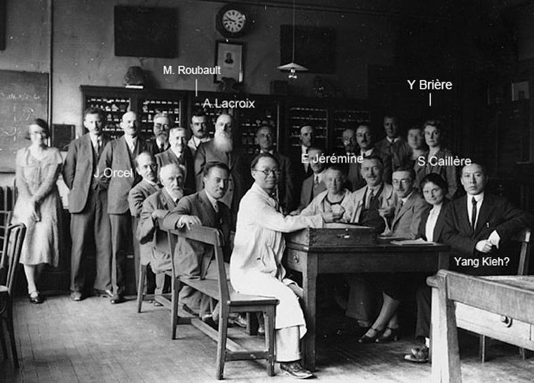Hard rocks have been instrumental as tools throughout the development of modern men. Today we find some hard rocks along the race course. We also tell you the story of another female pioneer of science: Yvonne Brière.
Cycling the roads might be the most efficient and stunning way to explore the Loire, Vendée and Corrèze landscapes. In 1916, cargo bikes were not democratized yet. Yvonne Brière, one of the first female mineralogists, who freshly started a PhD at the French Natural History Museum in Paris, opted for horse riding instead. A good reason for this is that Yvonne was chasing down and collecting rocks, and not the common type. She collected some of the heaviest rocks we know called eclogite.

During the Neolithic, and especially in Europe, people already noticed the super powers of eclogite. It has incredibly high density and hardness and is used it to make sharp tools like axes.
Beauty set in stone
Today, most geologists know what an eclogite is. They know its super powers as a witness of deep Earth’s processes. In 1916, that was quite different. The word eclogite was created in 1822 by René-Just Haüy from the Greek εκλογη. It means choice or election. Haüy was in awe by the beauty of this rock and by the singularity of the minerals which constitute it. It is mostly garnet that looks like a perfect little red ball. The other colour is an emerald green clinopyroxene, omphacite, surrounding the garnet. (Also see TDF stage 4).

Before the emergence of the plate tectonics’ concept, geologists pictured rock types organized as horizontal layers from the surface down to the center of the Earth. Sedimentary rocks were the top layers, organized chronologically. Then crystalline rocks in there were magmatic rocks (made from the fusion of other rocks), and that was it, basically.
Pioneer: Yvonne Brière
Yvonne investigated the origin of eclogites that she found from Île de Groix in Bretagne, to Loire Atlantique, Vendée, and Corrèze. She was the first to describe in detail the marvelous rocks found near Seilhac and Uzerche. It’s an hour’s ride north from where the stage takes place today. She started to think that, contrary to what every geologists thought at that time, eclogite might not be a magmatic rock anymore.
Yvonne was the first scientist to argue that the French eclogites were formed by the metamorphism of a magmatic oceanic crust. She based her idea on detailed observation and chemical analysis of her eclogite samples. This metamorphism —the transformation of rocks in response to changes in pressure and temperature— occurred because the former ocean was deeply buried and exhumed. We now know this. But those were processes that were difficult to picture before the emergence of plate tectonics.

Yvonne showed that the compositions of the eclogites were not only the same as those of gabbro, another type of rock. It also followed the chemical variations of the entire series of rocks characteristic of an oceanic crust. That’s the tholeiitic* series, formed by partial melting of the mantle at the mid-oceanic ridges. When she defended her thesis, her conclusions were severely criticized by her committee. Even her contemporaries like the pioneering and very famous (in the realm of metamorphic geology) Pentti Eskola was still in the camp of “magmatic origin” for eclogite.
Redemption
We know now that Yvonne was right **: eclogites are, indeed, (mostly) metamorphic rocks originating from oceanic rocks. The ones she described in detail then mark the suture of an ancient ocean that opened 470 million years ago. It subducted almost completely until the continents collided to form the supercontinent Pangea. That is the most “recent” supercontinent around 350-300 million years ago.
Along this suture, eclogites metamorphosed at great depths —more than 60 km— and managed to squeeze their way up during the collision that formed the Variscan mountain belt. This is how we find ancient oceans in the middle of mountains today. These eclogites are proof that very high mountains, such as the Himalayas, preceded the peaceful, smooth and low-lying landscapes of Corrèze.
Finally
And as for Yvonne, she continued her career as a mineralogist-petrographer in Madagascar (1923-1933) studying more than just hard rocks. She organized the mineralogy laboratory and set up the rocks’ collections. She left Madagascar in 1933, after her election in 1932, as vice-president of the French Mineralogical Society and her entry into the Malagasy Academy. Yvonne Brière was made a corresponding member of the Académie des sciences d’Outre-Mer in 1963. She died in 1981 but continues to inspire new generations of metamorphic geeks around the world.
G. Godard (emeritus Professor at IPGP, Paris) had the chance to meet Yvonne in 1981. She was 92 and was delighted to hear that her theory is now widely accepted.
* Tholeiitic rocks are the most common igneous rocks in Earth’s crust. They are usually formed underwater by magmatism along the mid-ocean ridges and make up much of the ocean crust. Tholeiitic rocks correspond to the various gabbro that follow the progressive chemical evolution of a crystallizing magma that is created from melted peridotite, which is the type of rock found in the Earth’s mantle.
**actually, we don’t; and there are still vivid debates about when exactly, how many and how big the(se) ocean(s) were cutting France in two. All that we know is that this Variscan orogen brought most of Western Europe together.






